Supply Chain Management: Flows, Integration, and Harmonization
VerifiedAdded on 2023/01/19
|10
|2292
|56
Report
AI Summary
This report delves into the intricacies of supply chain management, examining the critical roles of physical and information flows. It defines supply chain flows, including information, risk, financial, value, and product flows, with a specific emphasis on physical product movement and information exchange between suppliers and customers. The report highlights the bidirectional nature of information flow and its importance for successful supply chain operations. Furthermore, it explores the impact of these flows on integration and harmonization within a supply chain, emphasizing the need for collaboration and the integration of various business functions. The report underscores the importance of information sharing, integration, and the development of strong supplier relationships to improve overall supply chain performance. It also addresses the financial aspects of supply chains, emphasizing the importance of effective cash flow management. The analysis concludes by highlighting the significance of supplier integration for competitive advantage and improved business performance.
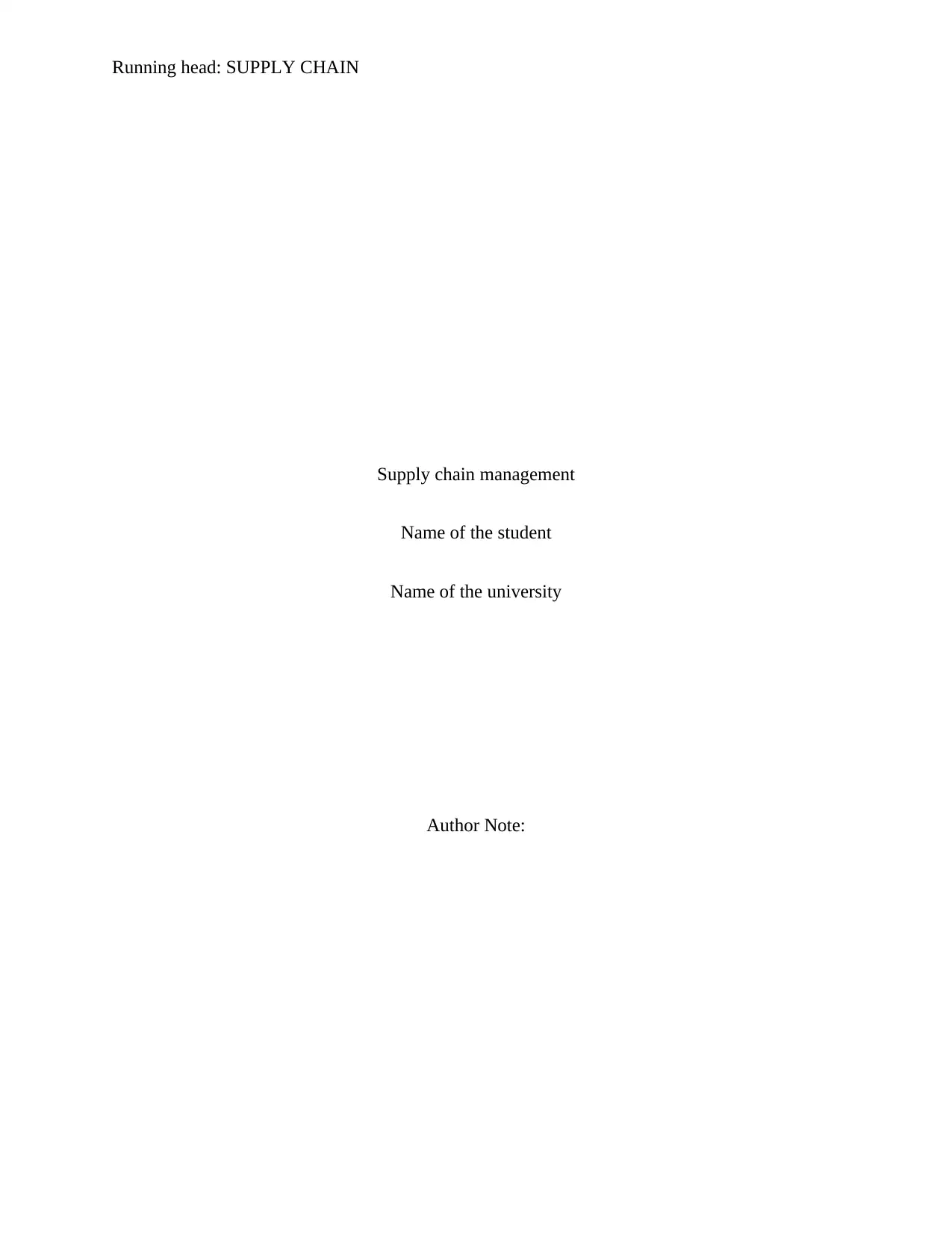
Running head: SUPPLY CHAIN
Supply chain management
Name of the student
Name of the university
Author Note:
Supply chain management
Name of the student
Name of the university
Author Note:
Paraphrase This Document
Need a fresh take? Get an instant paraphrase of this document with our AI Paraphraser
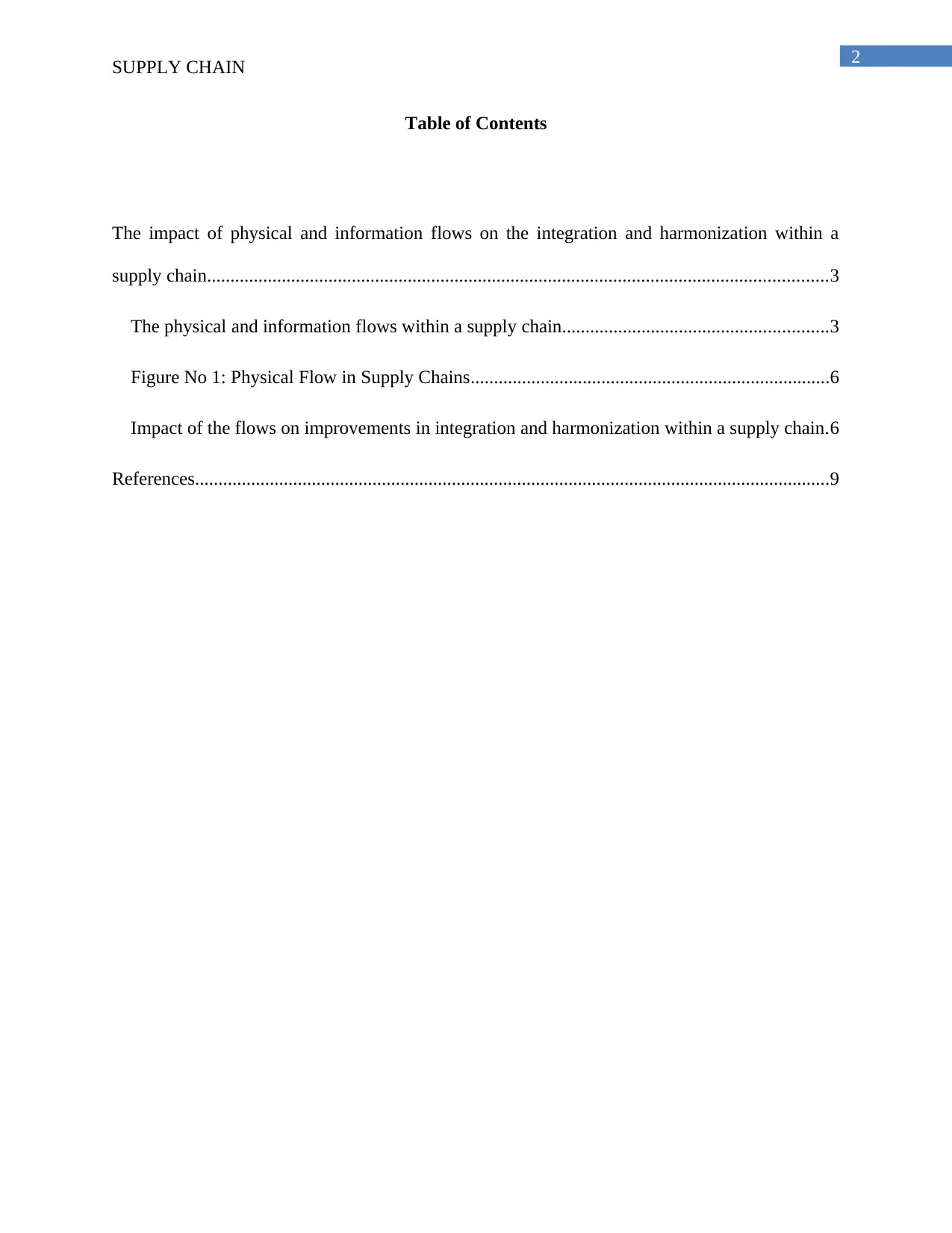
2
SUPPLY CHAIN
Table of Contents
The impact of physical and information flows on the integration and harmonization within a
supply chain.....................................................................................................................................3
The physical and information flows within a supply chain.........................................................3
Figure No 1: Physical Flow in Supply Chains.............................................................................6
Impact of the flows on improvements in integration and harmonization within a supply chain.6
References........................................................................................................................................9
SUPPLY CHAIN
Table of Contents
The impact of physical and information flows on the integration and harmonization within a
supply chain.....................................................................................................................................3
The physical and information flows within a supply chain.........................................................3
Figure No 1: Physical Flow in Supply Chains.............................................................................6
Impact of the flows on improvements in integration and harmonization within a supply chain.6
References........................................................................................................................................9
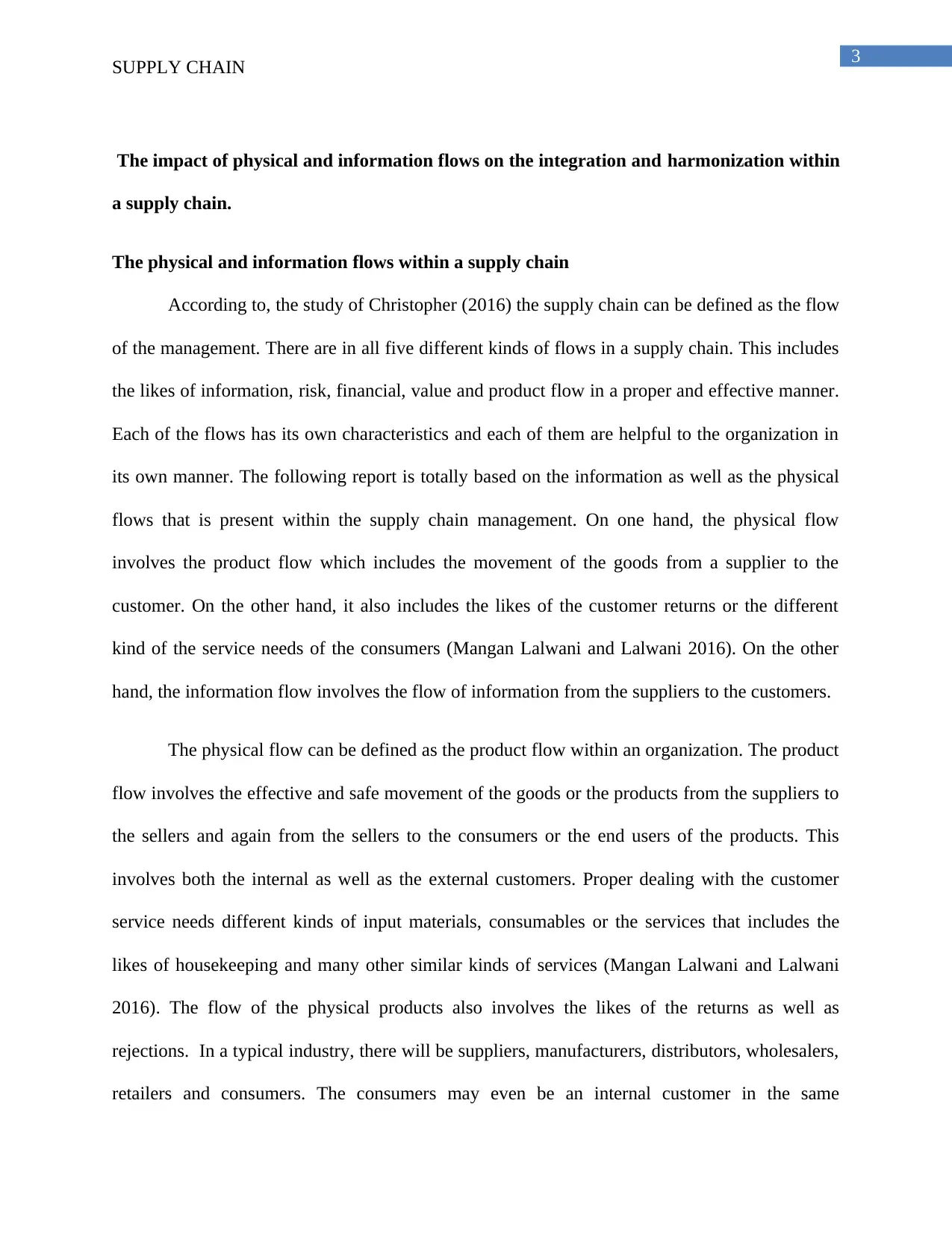
3
SUPPLY CHAIN
The impact of physical and information flows on the integration and harmonization within
a supply chain.
The physical and information flows within a supply chain
According to, the study of Christopher (2016) the supply chain can be defined as the flow
of the management. There are in all five different kinds of flows in a supply chain. This includes
the likes of information, risk, financial, value and product flow in a proper and effective manner.
Each of the flows has its own characteristics and each of them are helpful to the organization in
its own manner. The following report is totally based on the information as well as the physical
flows that is present within the supply chain management. On one hand, the physical flow
involves the product flow which includes the movement of the goods from a supplier to the
customer. On the other hand, it also includes the likes of the customer returns or the different
kind of the service needs of the consumers (Mangan Lalwani and Lalwani 2016). On the other
hand, the information flow involves the flow of information from the suppliers to the customers.
The physical flow can be defined as the product flow within an organization. The product
flow involves the effective and safe movement of the goods or the products from the suppliers to
the sellers and again from the sellers to the consumers or the end users of the products. This
involves both the internal as well as the external customers. Proper dealing with the customer
service needs different kinds of input materials, consumables or the services that includes the
likes of housekeeping and many other similar kinds of services (Mangan Lalwani and Lalwani
2016). The flow of the physical products also involves the likes of the returns as well as
rejections. In a typical industry, there will be suppliers, manufacturers, distributors, wholesalers,
retailers and consumers. The consumers may even be an internal customer in the same
SUPPLY CHAIN
The impact of physical and information flows on the integration and harmonization within
a supply chain.
The physical and information flows within a supply chain
According to, the study of Christopher (2016) the supply chain can be defined as the flow
of the management. There are in all five different kinds of flows in a supply chain. This includes
the likes of information, risk, financial, value and product flow in a proper and effective manner.
Each of the flows has its own characteristics and each of them are helpful to the organization in
its own manner. The following report is totally based on the information as well as the physical
flows that is present within the supply chain management. On one hand, the physical flow
involves the product flow which includes the movement of the goods from a supplier to the
customer. On the other hand, it also includes the likes of the customer returns or the different
kind of the service needs of the consumers (Mangan Lalwani and Lalwani 2016). On the other
hand, the information flow involves the flow of information from the suppliers to the customers.
The physical flow can be defined as the product flow within an organization. The product
flow involves the effective and safe movement of the goods or the products from the suppliers to
the sellers and again from the sellers to the consumers or the end users of the products. This
involves both the internal as well as the external customers. Proper dealing with the customer
service needs different kinds of input materials, consumables or the services that includes the
likes of housekeeping and many other similar kinds of services (Mangan Lalwani and Lalwani
2016). The flow of the physical products also involves the likes of the returns as well as
rejections. In a typical industry, there will be suppliers, manufacturers, distributors, wholesalers,
retailers and consumers. The consumers may even be an internal customer in the same
⊘ This is a preview!⊘
Do you want full access?
Subscribe today to unlock all pages.

Trusted by 1+ million students worldwide
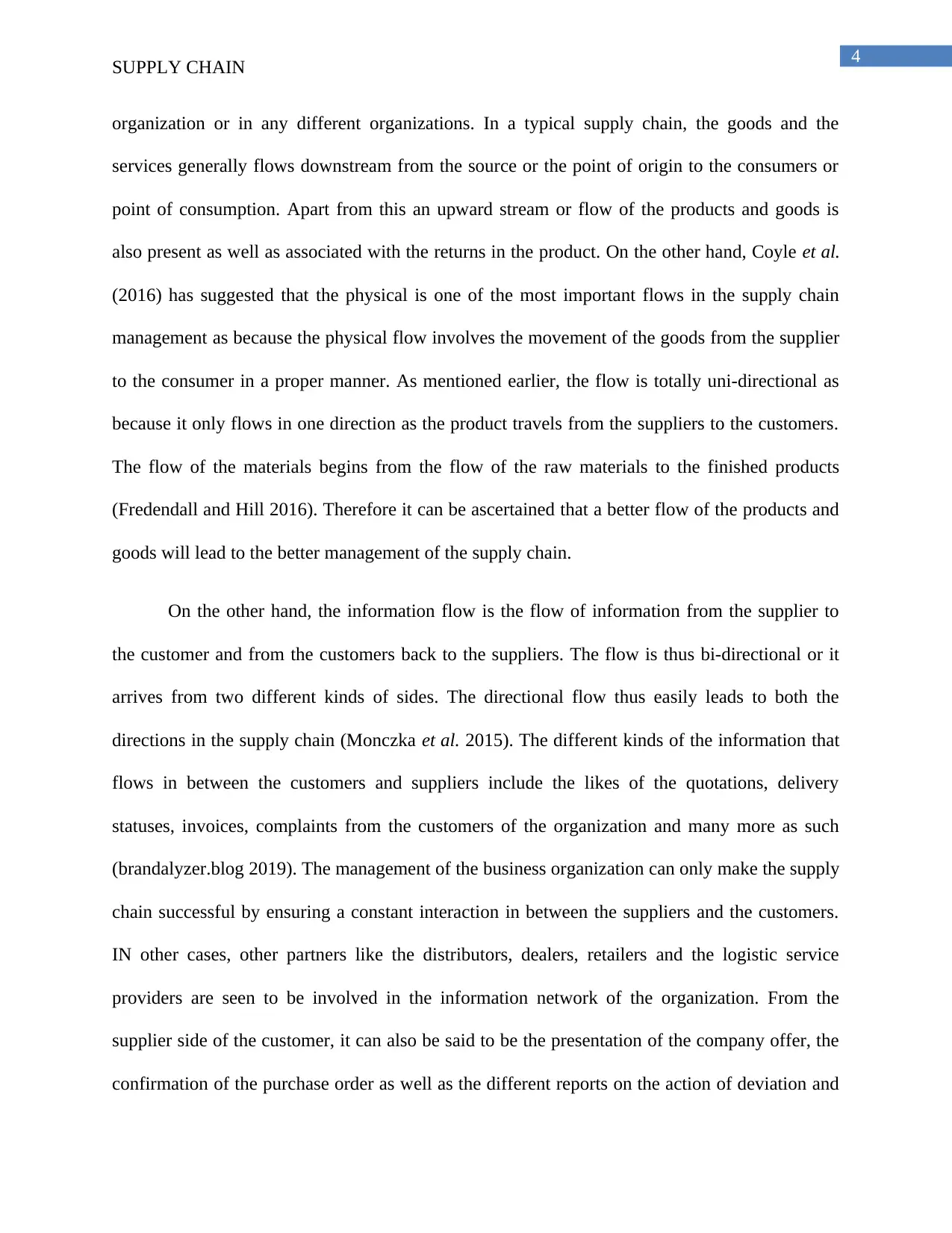
4
SUPPLY CHAIN
organization or in any different organizations. In a typical supply chain, the goods and the
services generally flows downstream from the source or the point of origin to the consumers or
point of consumption. Apart from this an upward stream or flow of the products and goods is
also present as well as associated with the returns in the product. On the other hand, Coyle et al.
(2016) has suggested that the physical is one of the most important flows in the supply chain
management as because the physical flow involves the movement of the goods from the supplier
to the consumer in a proper manner. As mentioned earlier, the flow is totally uni-directional as
because it only flows in one direction as the product travels from the suppliers to the customers.
The flow of the materials begins from the flow of the raw materials to the finished products
(Fredendall and Hill 2016). Therefore it can be ascertained that a better flow of the products and
goods will lead to the better management of the supply chain.
On the other hand, the information flow is the flow of information from the supplier to
the customer and from the customers back to the suppliers. The flow is thus bi-directional or it
arrives from two different kinds of sides. The directional flow thus easily leads to both the
directions in the supply chain (Monczka et al. 2015). The different kinds of the information that
flows in between the customers and suppliers include the likes of the quotations, delivery
statuses, invoices, complaints from the customers of the organization and many more as such
(brandalyzer.blog 2019). The management of the business organization can only make the supply
chain successful by ensuring a constant interaction in between the suppliers and the customers.
IN other cases, other partners like the distributors, dealers, retailers and the logistic service
providers are seen to be involved in the information network of the organization. From the
supplier side of the customer, it can also be said to be the presentation of the company offer, the
confirmation of the purchase order as well as the different reports on the action of deviation and
SUPPLY CHAIN
organization or in any different organizations. In a typical supply chain, the goods and the
services generally flows downstream from the source or the point of origin to the consumers or
point of consumption. Apart from this an upward stream or flow of the products and goods is
also present as well as associated with the returns in the product. On the other hand, Coyle et al.
(2016) has suggested that the physical is one of the most important flows in the supply chain
management as because the physical flow involves the movement of the goods from the supplier
to the consumer in a proper manner. As mentioned earlier, the flow is totally uni-directional as
because it only flows in one direction as the product travels from the suppliers to the customers.
The flow of the materials begins from the flow of the raw materials to the finished products
(Fredendall and Hill 2016). Therefore it can be ascertained that a better flow of the products and
goods will lead to the better management of the supply chain.
On the other hand, the information flow is the flow of information from the supplier to
the customer and from the customers back to the suppliers. The flow is thus bi-directional or it
arrives from two different kinds of sides. The directional flow thus easily leads to both the
directions in the supply chain (Monczka et al. 2015). The different kinds of the information that
flows in between the customers and suppliers include the likes of the quotations, delivery
statuses, invoices, complaints from the customers of the organization and many more as such
(brandalyzer.blog 2019). The management of the business organization can only make the supply
chain successful by ensuring a constant interaction in between the suppliers and the customers.
IN other cases, other partners like the distributors, dealers, retailers and the logistic service
providers are seen to be involved in the information network of the organization. From the
supplier side of the customer, it can also be said to be the presentation of the company offer, the
confirmation of the purchase order as well as the different reports on the action of deviation and
Paraphrase This Document
Need a fresh take? Get an instant paraphrase of this document with our AI Paraphraser
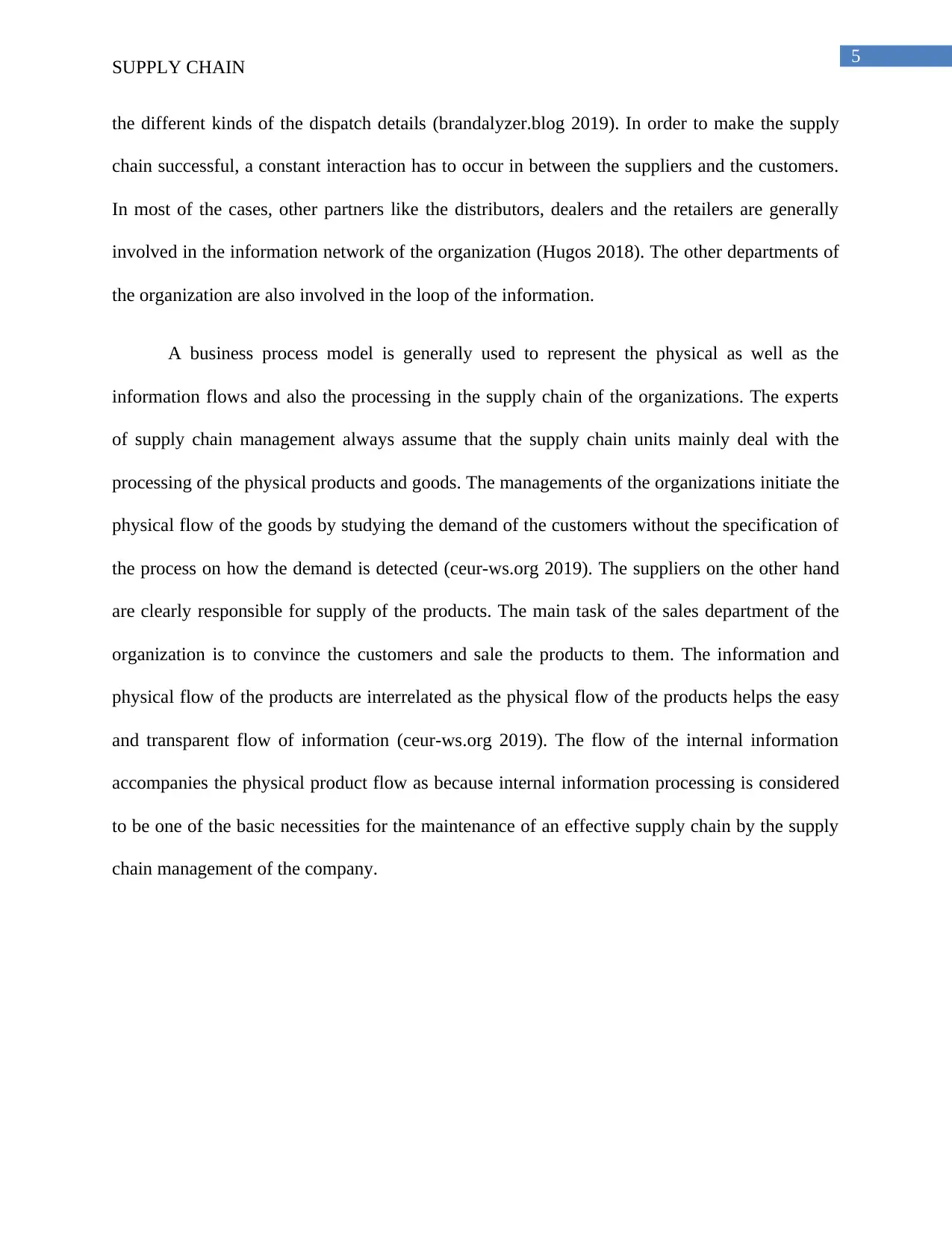
5
SUPPLY CHAIN
the different kinds of the dispatch details (brandalyzer.blog 2019). In order to make the supply
chain successful, a constant interaction has to occur in between the suppliers and the customers.
In most of the cases, other partners like the distributors, dealers and the retailers are generally
involved in the information network of the organization (Hugos 2018). The other departments of
the organization are also involved in the loop of the information.
A business process model is generally used to represent the physical as well as the
information flows and also the processing in the supply chain of the organizations. The experts
of supply chain management always assume that the supply chain units mainly deal with the
processing of the physical products and goods. The managements of the organizations initiate the
physical flow of the goods by studying the demand of the customers without the specification of
the process on how the demand is detected (ceur-ws.org 2019). The suppliers on the other hand
are clearly responsible for supply of the products. The main task of the sales department of the
organization is to convince the customers and sale the products to them. The information and
physical flow of the products are interrelated as the physical flow of the products helps the easy
and transparent flow of information (ceur-ws.org 2019). The flow of the internal information
accompanies the physical product flow as because internal information processing is considered
to be one of the basic necessities for the maintenance of an effective supply chain by the supply
chain management of the company.
SUPPLY CHAIN
the different kinds of the dispatch details (brandalyzer.blog 2019). In order to make the supply
chain successful, a constant interaction has to occur in between the suppliers and the customers.
In most of the cases, other partners like the distributors, dealers and the retailers are generally
involved in the information network of the organization (Hugos 2018). The other departments of
the organization are also involved in the loop of the information.
A business process model is generally used to represent the physical as well as the
information flows and also the processing in the supply chain of the organizations. The experts
of supply chain management always assume that the supply chain units mainly deal with the
processing of the physical products and goods. The managements of the organizations initiate the
physical flow of the goods by studying the demand of the customers without the specification of
the process on how the demand is detected (ceur-ws.org 2019). The suppliers on the other hand
are clearly responsible for supply of the products. The main task of the sales department of the
organization is to convince the customers and sale the products to them. The information and
physical flow of the products are interrelated as the physical flow of the products helps the easy
and transparent flow of information (ceur-ws.org 2019). The flow of the internal information
accompanies the physical product flow as because internal information processing is considered
to be one of the basic necessities for the maintenance of an effective supply chain by the supply
chain management of the company.
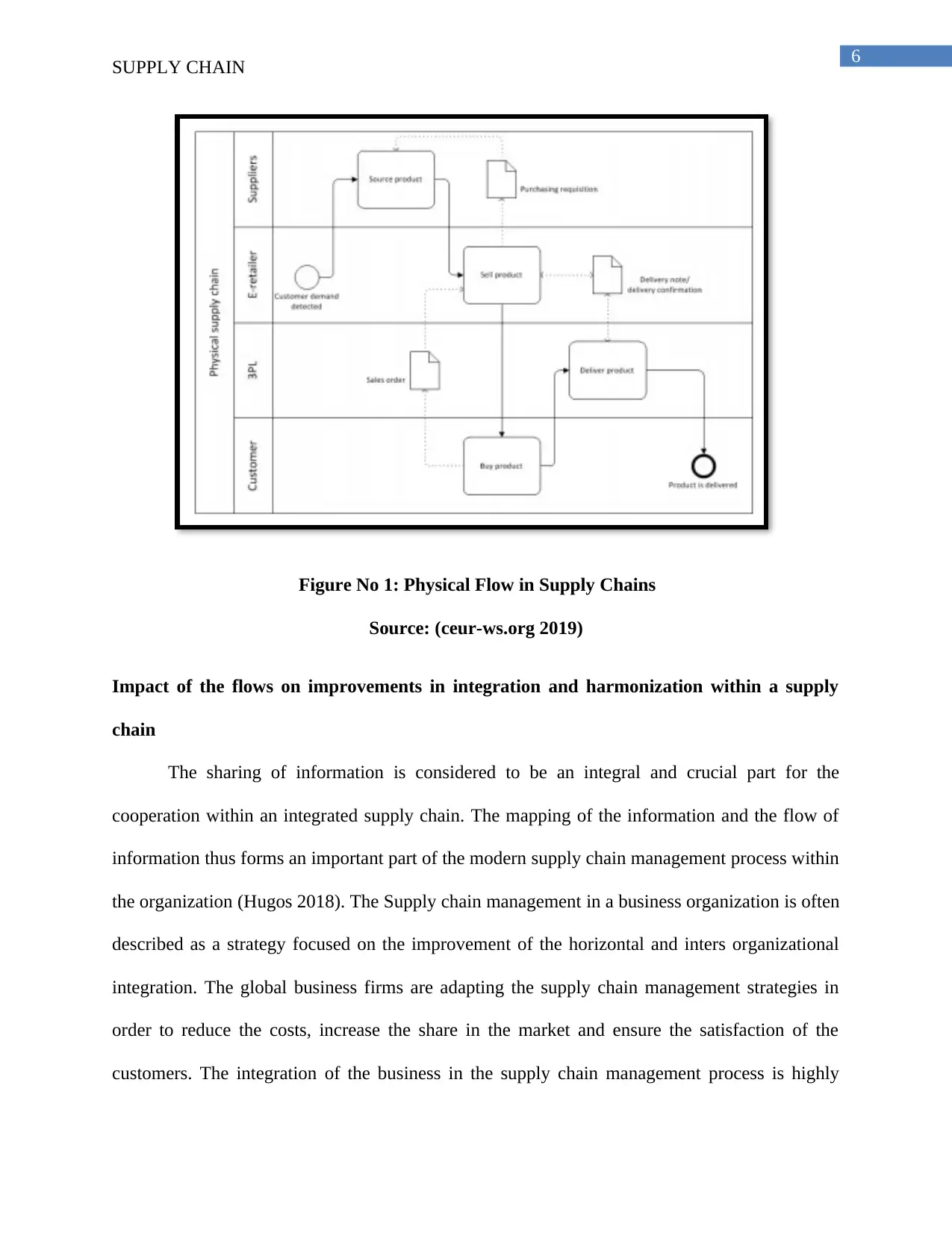
6
SUPPLY CHAIN
Figure No 1: Physical Flow in Supply Chains
Source: (ceur-ws.org 2019)
Impact of the flows on improvements in integration and harmonization within a supply
chain
The sharing of information is considered to be an integral and crucial part for the
cooperation within an integrated supply chain. The mapping of the information and the flow of
information thus forms an important part of the modern supply chain management process within
the organization (Hugos 2018). The Supply chain management in a business organization is often
described as a strategy focused on the improvement of the horizontal and inters organizational
integration. The global business firms are adapting the supply chain management strategies in
order to reduce the costs, increase the share in the market and ensure the satisfaction of the
customers. The integration of the business in the supply chain management process is highly
SUPPLY CHAIN
Figure No 1: Physical Flow in Supply Chains
Source: (ceur-ws.org 2019)
Impact of the flows on improvements in integration and harmonization within a supply
chain
The sharing of information is considered to be an integral and crucial part for the
cooperation within an integrated supply chain. The mapping of the information and the flow of
information thus forms an important part of the modern supply chain management process within
the organization (Hugos 2018). The Supply chain management in a business organization is often
described as a strategy focused on the improvement of the horizontal and inters organizational
integration. The global business firms are adapting the supply chain management strategies in
order to reduce the costs, increase the share in the market and ensure the satisfaction of the
customers. The integration of the business in the supply chain management process is highly
⊘ This is a preview!⊘
Do you want full access?
Subscribe today to unlock all pages.

Trusted by 1+ million students worldwide
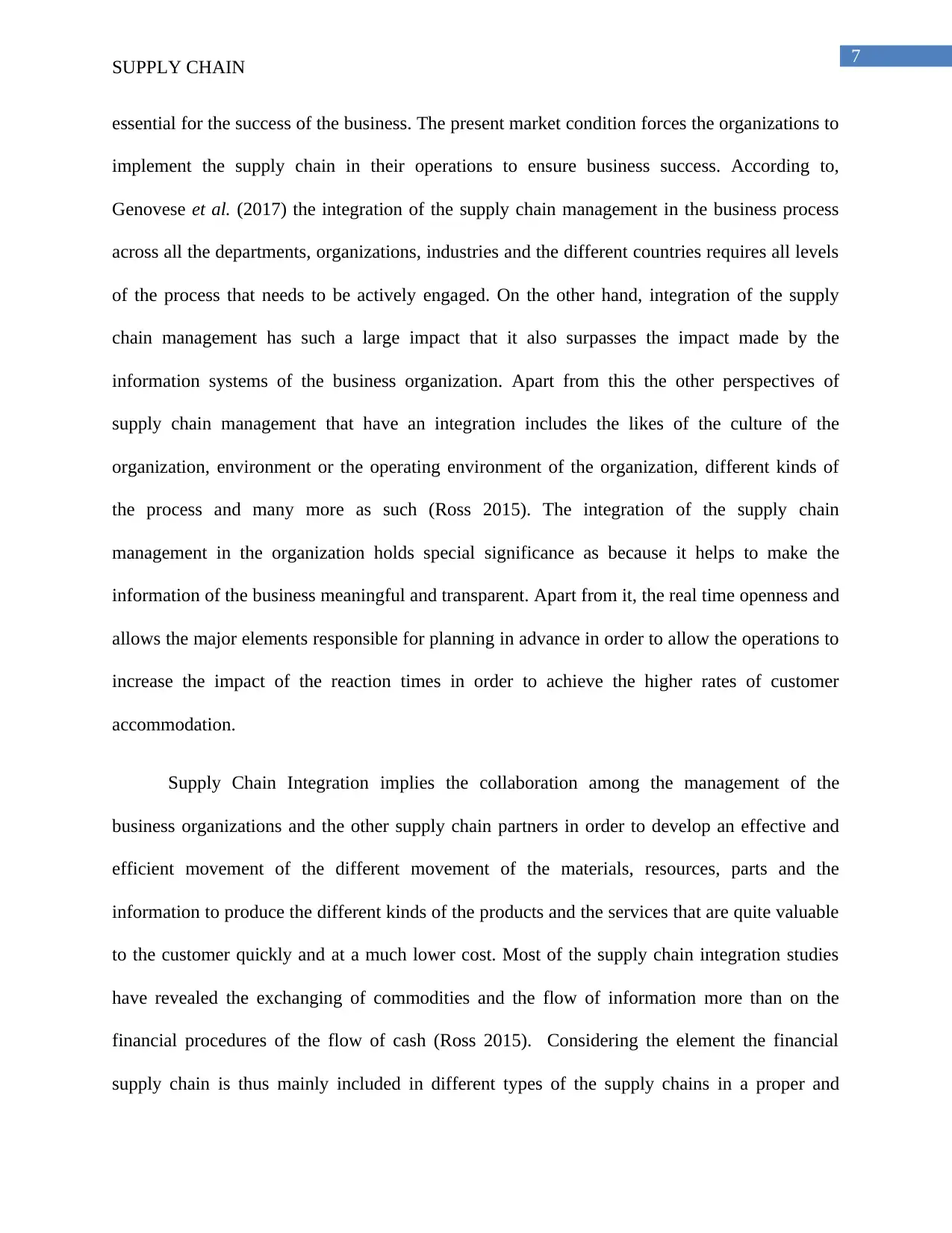
7
SUPPLY CHAIN
essential for the success of the business. The present market condition forces the organizations to
implement the supply chain in their operations to ensure business success. According to,
Genovese et al. (2017) the integration of the supply chain management in the business process
across all the departments, organizations, industries and the different countries requires all levels
of the process that needs to be actively engaged. On the other hand, integration of the supply
chain management has such a large impact that it also surpasses the impact made by the
information systems of the business organization. Apart from this the other perspectives of
supply chain management that have an integration includes the likes of the culture of the
organization, environment or the operating environment of the organization, different kinds of
the process and many more as such (Ross 2015). The integration of the supply chain
management in the organization holds special significance as because it helps to make the
information of the business meaningful and transparent. Apart from it, the real time openness and
allows the major elements responsible for planning in advance in order to allow the operations to
increase the impact of the reaction times in order to achieve the higher rates of customer
accommodation.
Supply Chain Integration implies the collaboration among the management of the
business organizations and the other supply chain partners in order to develop an effective and
efficient movement of the different movement of the materials, resources, parts and the
information to produce the different kinds of the products and the services that are quite valuable
to the customer quickly and at a much lower cost. Most of the supply chain integration studies
have revealed the exchanging of commodities and the flow of information more than on the
financial procedures of the flow of cash (Ross 2015). Considering the element the financial
supply chain is thus mainly included in different types of the supply chains in a proper and
SUPPLY CHAIN
essential for the success of the business. The present market condition forces the organizations to
implement the supply chain in their operations to ensure business success. According to,
Genovese et al. (2017) the integration of the supply chain management in the business process
across all the departments, organizations, industries and the different countries requires all levels
of the process that needs to be actively engaged. On the other hand, integration of the supply
chain management has such a large impact that it also surpasses the impact made by the
information systems of the business organization. Apart from this the other perspectives of
supply chain management that have an integration includes the likes of the culture of the
organization, environment or the operating environment of the organization, different kinds of
the process and many more as such (Ross 2015). The integration of the supply chain
management in the organization holds special significance as because it helps to make the
information of the business meaningful and transparent. Apart from it, the real time openness and
allows the major elements responsible for planning in advance in order to allow the operations to
increase the impact of the reaction times in order to achieve the higher rates of customer
accommodation.
Supply Chain Integration implies the collaboration among the management of the
business organizations and the other supply chain partners in order to develop an effective and
efficient movement of the different movement of the materials, resources, parts and the
information to produce the different kinds of the products and the services that are quite valuable
to the customer quickly and at a much lower cost. Most of the supply chain integration studies
have revealed the exchanging of commodities and the flow of information more than on the
financial procedures of the flow of cash (Ross 2015). Considering the element the financial
supply chain is thus mainly included in different types of the supply chains in a proper and
Paraphrase This Document
Need a fresh take? Get an instant paraphrase of this document with our AI Paraphraser
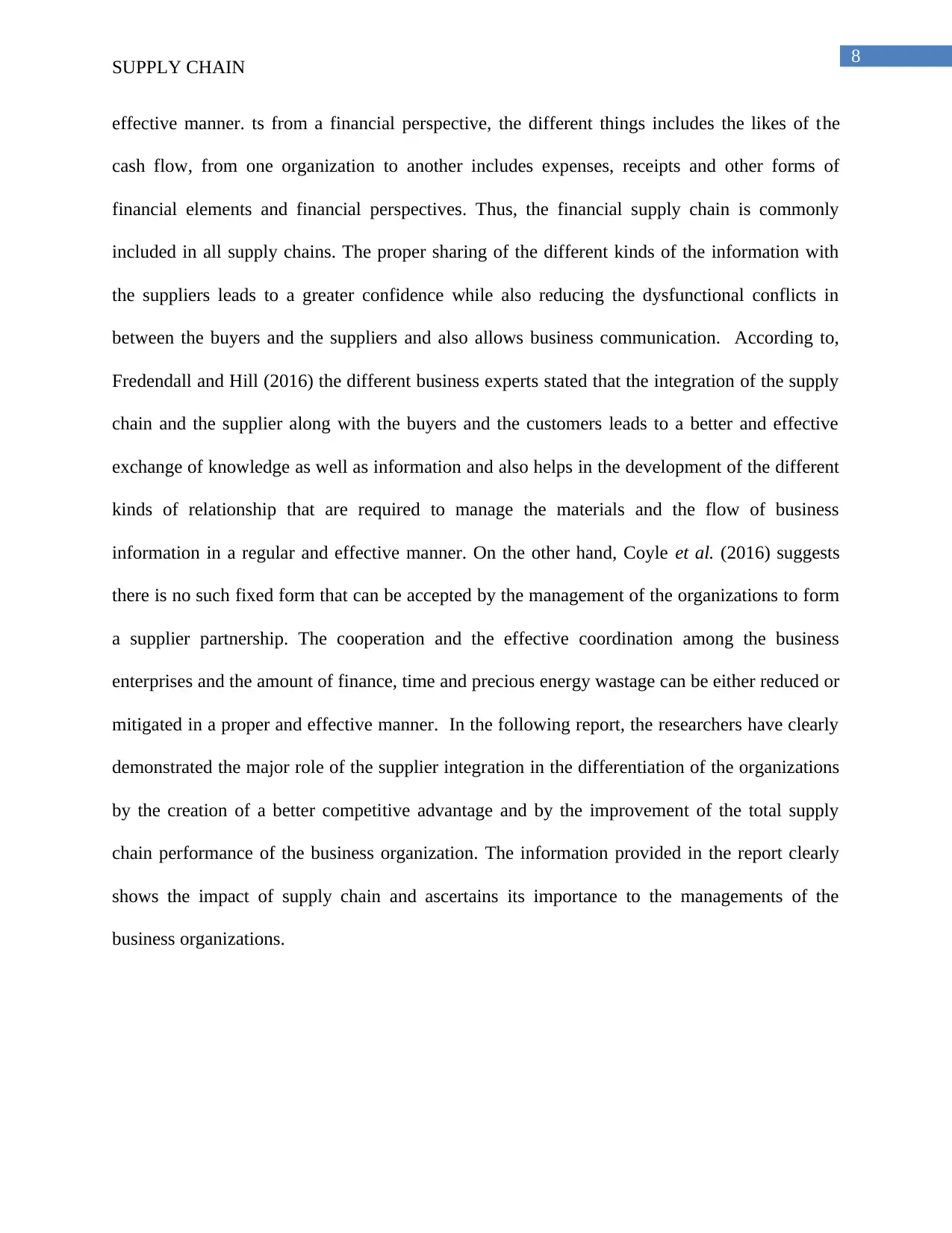
8
SUPPLY CHAIN
effective manner. ts from a financial perspective, the different things includes the likes of the
cash flow, from one organization to another includes expenses, receipts and other forms of
financial elements and financial perspectives. Thus, the financial supply chain is commonly
included in all supply chains. The proper sharing of the different kinds of the information with
the suppliers leads to a greater confidence while also reducing the dysfunctional conflicts in
between the buyers and the suppliers and also allows business communication. According to,
Fredendall and Hill (2016) the different business experts stated that the integration of the supply
chain and the supplier along with the buyers and the customers leads to a better and effective
exchange of knowledge as well as information and also helps in the development of the different
kinds of relationship that are required to manage the materials and the flow of business
information in a regular and effective manner. On the other hand, Coyle et al. (2016) suggests
there is no such fixed form that can be accepted by the management of the organizations to form
a supplier partnership. The cooperation and the effective coordination among the business
enterprises and the amount of finance, time and precious energy wastage can be either reduced or
mitigated in a proper and effective manner. In the following report, the researchers have clearly
demonstrated the major role of the supplier integration in the differentiation of the organizations
by the creation of a better competitive advantage and by the improvement of the total supply
chain performance of the business organization. The information provided in the report clearly
shows the impact of supply chain and ascertains its importance to the managements of the
business organizations.
SUPPLY CHAIN
effective manner. ts from a financial perspective, the different things includes the likes of the
cash flow, from one organization to another includes expenses, receipts and other forms of
financial elements and financial perspectives. Thus, the financial supply chain is commonly
included in all supply chains. The proper sharing of the different kinds of the information with
the suppliers leads to a greater confidence while also reducing the dysfunctional conflicts in
between the buyers and the suppliers and also allows business communication. According to,
Fredendall and Hill (2016) the different business experts stated that the integration of the supply
chain and the supplier along with the buyers and the customers leads to a better and effective
exchange of knowledge as well as information and also helps in the development of the different
kinds of relationship that are required to manage the materials and the flow of business
information in a regular and effective manner. On the other hand, Coyle et al. (2016) suggests
there is no such fixed form that can be accepted by the management of the organizations to form
a supplier partnership. The cooperation and the effective coordination among the business
enterprises and the amount of finance, time and precious energy wastage can be either reduced or
mitigated in a proper and effective manner. In the following report, the researchers have clearly
demonstrated the major role of the supplier integration in the differentiation of the organizations
by the creation of a better competitive advantage and by the improvement of the total supply
chain performance of the business organization. The information provided in the report clearly
shows the impact of supply chain and ascertains its importance to the managements of the
business organizations.
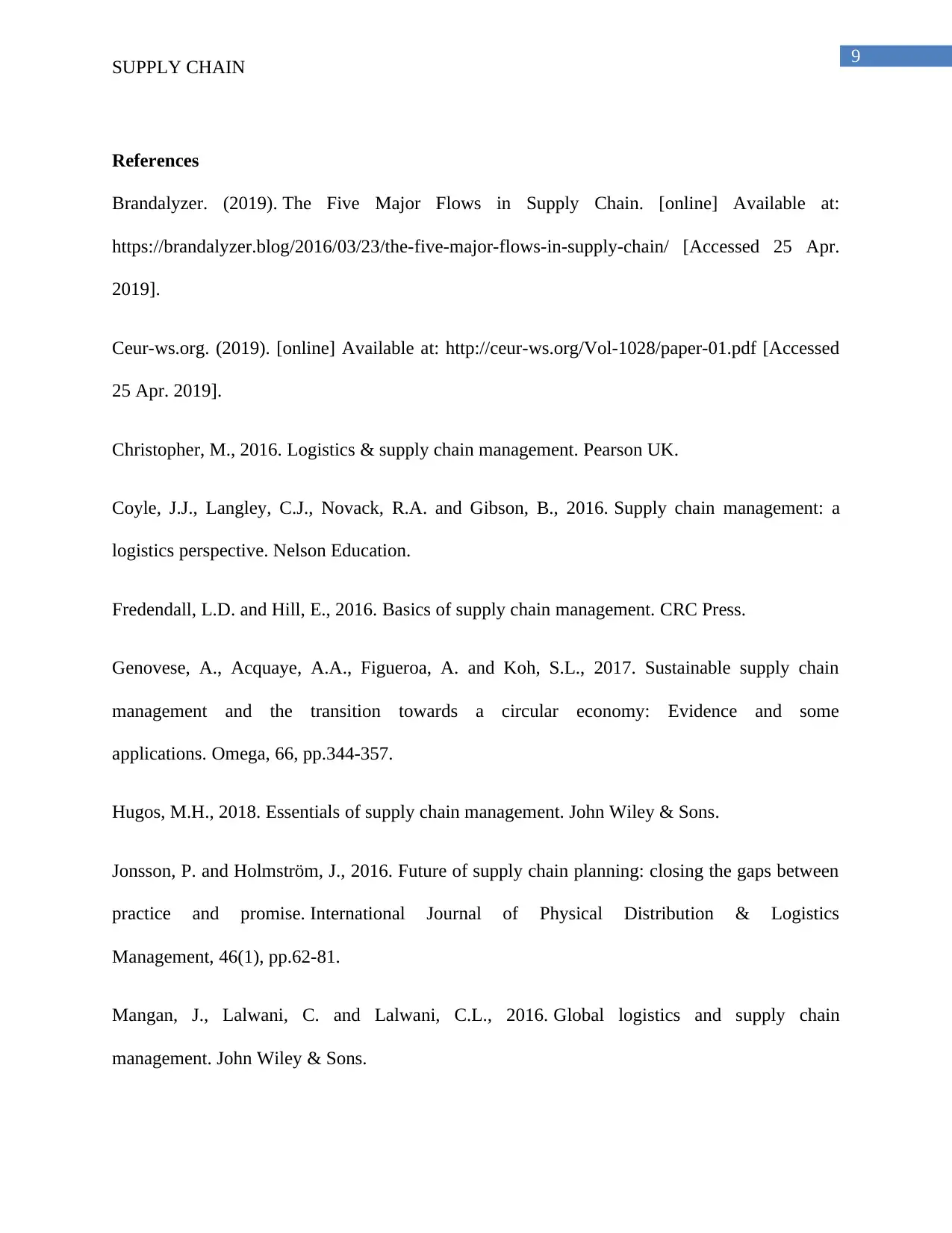
9
SUPPLY CHAIN
References
Brandalyzer. (2019). The Five Major Flows in Supply Chain. [online] Available at:
https://brandalyzer.blog/2016/03/23/the-five-major-flows-in-supply-chain/ [Accessed 25 Apr.
2019].
Ceur-ws.org. (2019). [online] Available at: http://ceur-ws.org/Vol-1028/paper-01.pdf [Accessed
25 Apr. 2019].
Christopher, M., 2016. Logistics & supply chain management. Pearson UK.
Coyle, J.J., Langley, C.J., Novack, R.A. and Gibson, B., 2016. Supply chain management: a
logistics perspective. Nelson Education.
Fredendall, L.D. and Hill, E., 2016. Basics of supply chain management. CRC Press.
Genovese, A., Acquaye, A.A., Figueroa, A. and Koh, S.L., 2017. Sustainable supply chain
management and the transition towards a circular economy: Evidence and some
applications. Omega, 66, pp.344-357.
Hugos, M.H., 2018. Essentials of supply chain management. John Wiley & Sons.
Jonsson, P. and Holmström, J., 2016. Future of supply chain planning: closing the gaps between
practice and promise. International Journal of Physical Distribution & Logistics
Management, 46(1), pp.62-81.
Mangan, J., Lalwani, C. and Lalwani, C.L., 2016. Global logistics and supply chain
management. John Wiley & Sons.
SUPPLY CHAIN
References
Brandalyzer. (2019). The Five Major Flows in Supply Chain. [online] Available at:
https://brandalyzer.blog/2016/03/23/the-five-major-flows-in-supply-chain/ [Accessed 25 Apr.
2019].
Ceur-ws.org. (2019). [online] Available at: http://ceur-ws.org/Vol-1028/paper-01.pdf [Accessed
25 Apr. 2019].
Christopher, M., 2016. Logistics & supply chain management. Pearson UK.
Coyle, J.J., Langley, C.J., Novack, R.A. and Gibson, B., 2016. Supply chain management: a
logistics perspective. Nelson Education.
Fredendall, L.D. and Hill, E., 2016. Basics of supply chain management. CRC Press.
Genovese, A., Acquaye, A.A., Figueroa, A. and Koh, S.L., 2017. Sustainable supply chain
management and the transition towards a circular economy: Evidence and some
applications. Omega, 66, pp.344-357.
Hugos, M.H., 2018. Essentials of supply chain management. John Wiley & Sons.
Jonsson, P. and Holmström, J., 2016. Future of supply chain planning: closing the gaps between
practice and promise. International Journal of Physical Distribution & Logistics
Management, 46(1), pp.62-81.
Mangan, J., Lalwani, C. and Lalwani, C.L., 2016. Global logistics and supply chain
management. John Wiley & Sons.
⊘ This is a preview!⊘
Do you want full access?
Subscribe today to unlock all pages.

Trusted by 1+ million students worldwide
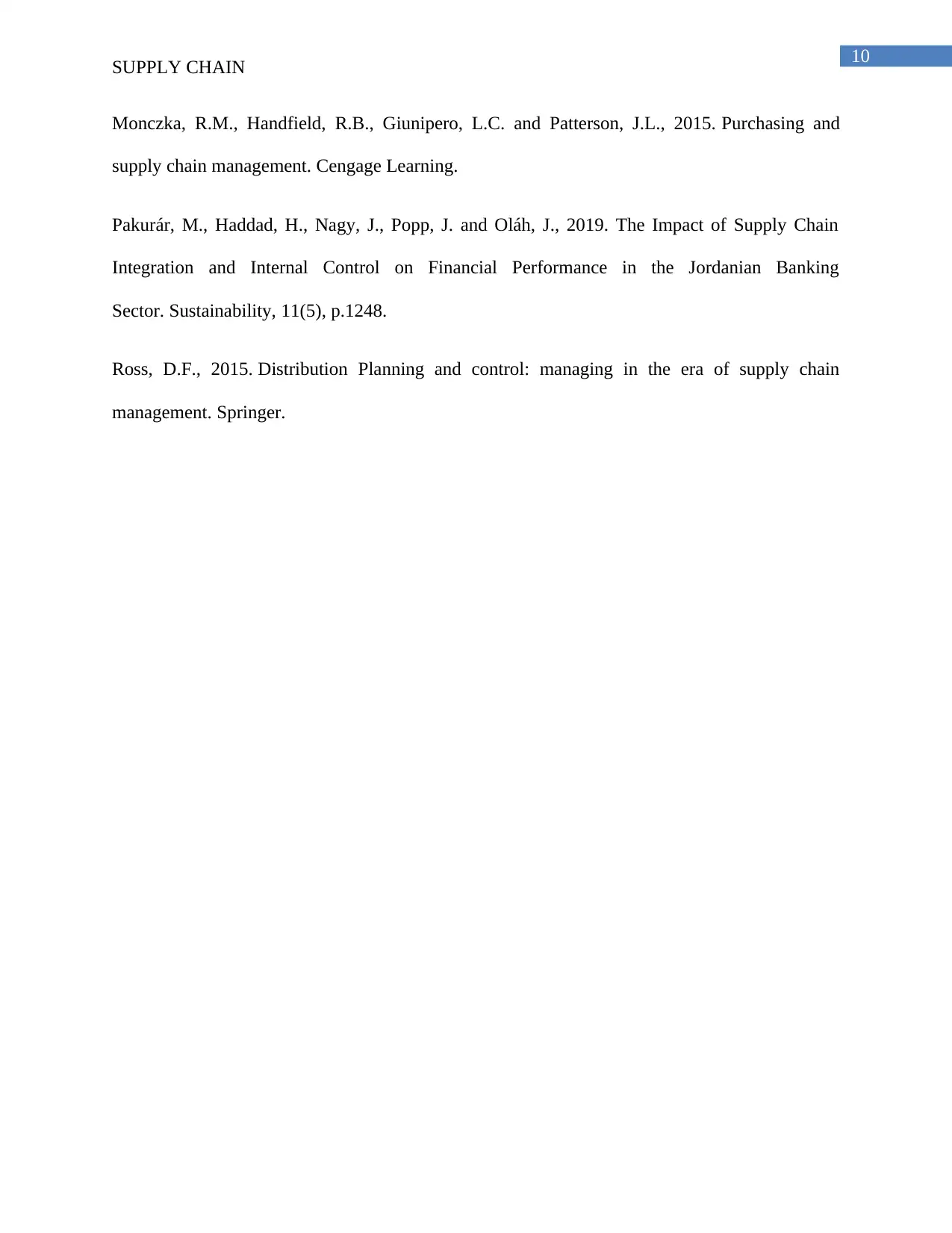
10
SUPPLY CHAIN
Monczka, R.M., Handfield, R.B., Giunipero, L.C. and Patterson, J.L., 2015. Purchasing and
supply chain management. Cengage Learning.
Pakurár, M., Haddad, H., Nagy, J., Popp, J. and Oláh, J., 2019. The Impact of Supply Chain
Integration and Internal Control on Financial Performance in the Jordanian Banking
Sector. Sustainability, 11(5), p.1248.
Ross, D.F., 2015. Distribution Planning and control: managing in the era of supply chain
management. Springer.
SUPPLY CHAIN
Monczka, R.M., Handfield, R.B., Giunipero, L.C. and Patterson, J.L., 2015. Purchasing and
supply chain management. Cengage Learning.
Pakurár, M., Haddad, H., Nagy, J., Popp, J. and Oláh, J., 2019. The Impact of Supply Chain
Integration and Internal Control on Financial Performance in the Jordanian Banking
Sector. Sustainability, 11(5), p.1248.
Ross, D.F., 2015. Distribution Planning and control: managing in the era of supply chain
management. Springer.
1 out of 10
Related Documents
Your All-in-One AI-Powered Toolkit for Academic Success.
+13062052269
info@desklib.com
Available 24*7 on WhatsApp / Email
![[object Object]](/_next/static/media/star-bottom.7253800d.svg)
Unlock your academic potential
Copyright © 2020–2025 A2Z Services. All Rights Reserved. Developed and managed by ZUCOL.




